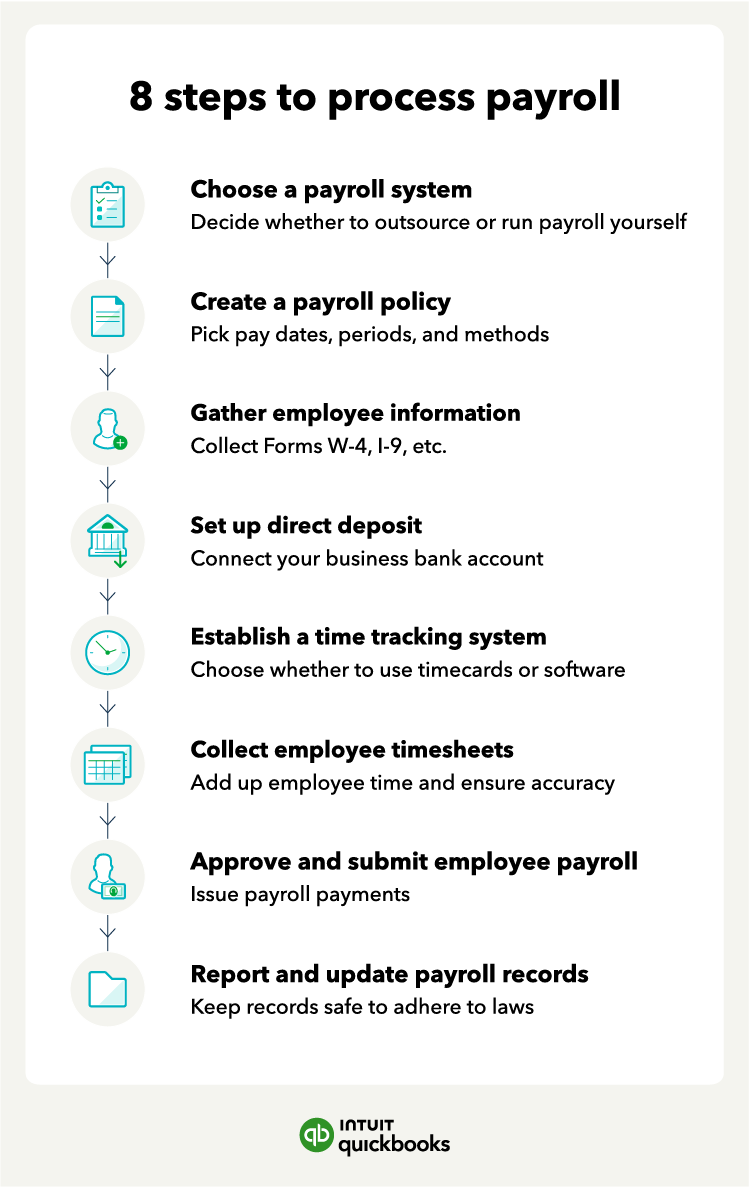

If you’re a small business owner, chances are good you’re the one handling payroll . Figuring out how to process payroll can be intimidating, but don’t worry. Processing payroll is easier than you think. This guide will take you through the payroll process step by step, so you’re confident and ready for payday.
Payroll processing is the act of managing employee payments. It covers everything from entering an employee into your payroll software to giving them their paychecks. The basic payroll processing steps involve collecting employee information, and setting up a schedule, and issuing payments, all while keeping accurate records.
For processing employee payroll, there are eight basic steps from start to finish:

How does payroll work? Processing payroll isn’t just about compensating your employees. It’s part of operating your business legally—according to state laws and the Fair Labor Standards Act (FLSA) .
The FLSA has several requirements that fit into your payroll process—from tracking employee time at work to recordkeeping. You’ll want to remember those regulations when figuring out how to process payroll.
There are three basic payroll systems:
Before you commit to one system over another, consider factors like business growth, employee benefits, and the complexity of your state’s payroll taxes and laws.
After deciding on the type of payroll, whether in-house or outsourcing payroll, it’s time to set up a payroll policy. First, you’ll want to review your local labor laws, state overtime laws, and federal labor laws. A common FLSA violation to watch out for is unpaid overtime, which can happen accidentally when you don’t know the rules.
Here are other things to include in your payroll policy:
Once this is in place, you’re ready to start collecting employee information.
Now it’s time to get the necessary information from your employees to ensure you’re paying them the correct amount, as well as making the necessary withholdings and deductions. That means collecting certain forms like Form W-4 .
Such documents will provide each employee’s personal information, Social Security number, and tax filing status. If your payroll includes employee health insurance or retirement savings, you’ll need documentation showing the employee has approved additional deductions.
Lastly, if you plan to offer direct deposit, now is the time to get employee consent and collect their banking information.
As a business owner, you can set up direct deposit directly through your business’s bank account or through your payroll service provider. Direct deposit is convenient for both your and your employees. If your employees have opted for direct deposit, they’ll have to give you some information:
Once you have all that, the next step is to transfer that information to your payroll software or bank.
With a payroll policy, employee info, and a direct deposit in place, it’s time to track hours. The FLSA requires employers to maintain accurate records of work hours for all nonexempt employees. In most cases, non-exempt (as opposed to exempt) includes hourly employees.
One way to maintain those records is to track hours manually and ask employees to write down when they clock in and out. Otherwise, you might try a time-tracking software that holds onto employee timesheet records for you. Either way, you’ll want to train employees to track their time as soon as possible.
Depending on the payroll processor, those timesheets may already be sitting inside your payroll software, waiting for approval. If not, now is the time to import them into your payroll software. If you have paper time cards, you’ll need to add up the hours, check for any mistakes, and transcribe the numbers to your payroll records.
Congratulations—the payroll date is nearing. It’s almost time to officially run your payroll, so it’s time to submit it.
Once you approve all your employee time cards, you’re ready to run payroll and issue payments. Approval is one of the most important steps when running payroll for employees. This is your chance to make sure all the hours add up and are correct so payroll is accurate.
Now that the payroll payments are on their way to employees, it’s time to update your payroll records. Those records must show you withheld all necessary taxes and deductions.
Payroll records are important for other reasons too. For instance, the Age Discrimination in Employment Act (ADEA) requires employers to keep all payroll records for three years. That information must include any employee benefit plans (including retirement or insurance) and any written seniority or merit system.
There are ways to ensure your payroll runs as smoothly as possible. Here are some tips and tricks to help get you through your payroll cycle:
The more complicated your payroll, or the more components and calculations you have, the more likely you’ll want to try payroll software or outsource payroll altogether.
Automated payroll and time-tracking tools can reduce the time to process payroll. One reason is that most payroll processing solutions calculate payroll taxes for you, which could take a while if done by hand.
Meanwhile, payroll services like QuickBooks Payroll can remove that hassle, as well as help speed up the time that your employees get their paycheck with direct deposit.
Processing payroll may take several hours, depending on your number of employees and the tools you use. The more manual the process, the longer it will take. The size of a company and the number of employees also play a role in determining processing times. Smaller businesses with a limited employees count may be able to process payroll more quickly than larger organizations with complex pay structures.
Can you process payroll manually?Yes, it is possible to process payroll manually. The process generally involves several steps. First, you need to determine the gross wage amount for each employee, then calculate and subtract various withholdings, such as income taxes. You’ll then determine the net pay amount, pay your employees, and make tax deposits to the relevant tax agencies on time to comply with tax regulations.
What are the three stages of payroll processing?The three stages of payroll processing are data collection, calculation, and disbursement. In the data collection stage, employers gather information such as employee details, hours worked, and any deductions or withholdings. This information helps with the calculation stage, where tax withholdings, overtime wages, and other variables determine the net payment amount. In the disbursement stage, you make payments to employees through methods such as direct deposit or paper checks.
What is a payroll processing checklist?A payroll processing checklist is a tool that helps ensure accurate and compliant payroll. It includes various components such as classifying workers correctly, collecting and tallying hours, verifying payment information, processing payroll on time, and depositing and reporting employment taxes correctly.
QuickBooks Online Payroll & Contractor Payments: Money movement services are provided by Intuit Payments Inc., licensed as a Money Transmitter by the New York State Department of Financial Services, subject to eligibility criteria, credit and application approval. For more information about Intuit Payments Inc.’s money transmission licenses, please visit https://www.intuit.com/legal/licenses/payment-licenses/

Marshall Hargrave is a financial writer with over 15 years of expertise spanning the finance and investing fields. He has experience as an editor for Investopedia and has worked with the likes of the Consumer Bankers Association and National Venture Capital Association. Marshall is a former Securities & Exchange Commission-registered investment adviser and holds a Bachelor's degree in finance from Appalachian State University.



Money movement services are provided by Intuit Payments Inc., licensed as a Money Transmitter by the New York State Department of Financial Services. For more information about Intuit Payments' money transmission licenses, please visit https://www.intuit.com/legal/licenses/payment-licenses/.
This content is for information purposes only and should not be considered legal, accounting, or tax advice, or a substitute for obtaining such advice specific to your business. Additional information and exceptions may apply. Applicable laws may vary by state or locality. No assurance is given that the information is comprehensive in its coverage or that it is suitable in dealing with a customer’s particular situation. Intuit Inc. does not have any responsibility for updating or revising any information presented herein. Accordingly, the information provided should not be relied upon as a substitute for independent research. Intuit Inc. does not warrant that the material contained herein will continue to be accurate nor that it is completely free of errors when published. Readers should verify statements before relying on them.
We provide third-party links as a convenience and for informational purposes only. Intuit does not endorse or approve these products and services, or the opinions of these corporations or organizations or individuals. Intuit accepts no responsibility for the accuracy, legality, or content on these sites.